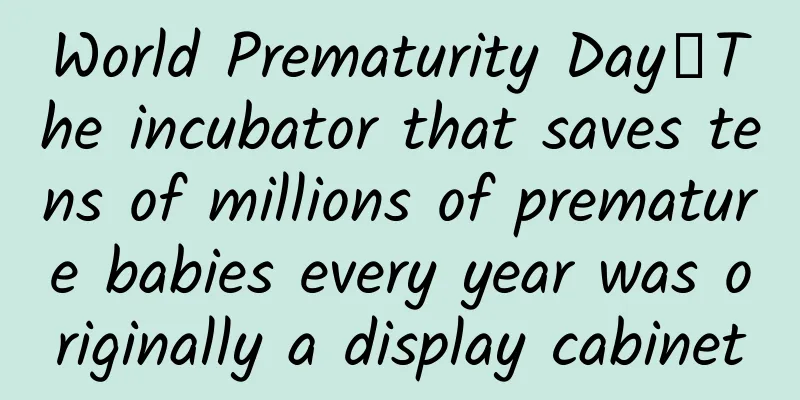World Prematurity Day丨The incubator that saves tens of millions of premature babies every year was originally a display cabinet

|
Premature birth is the leading cause of neonatal death. According to a United Nations report, an estimated 13.4 million premature babies were born in 2020, of which nearly 1 million died from complications of premature birth. Today is the 13th World Prematurity Day. Let us take a look at the true story of a man who saved thousands of premature babies but was despised by the medical community. Image credit: Beth Allen When Martin A. Couney finally transported three baskets of babies across the English Channel and got off the boat, he immediately checked each child with trepidation to see if they were safe, and finally breathed a sigh of relief. At this point he had no time to think about whether this was too risky . He was only focused on taking these premature babies sleeping next to the thermos to Earl's Court in London as soon as possible and putting them in a cabinet so that they could be seen by the British at the Victorian exhibition. He was assigned to the entertainment area, and was quite dissatisfied at first, but later he was relieved - even if watching babies was a form of entertainment, the audience would certainly not ignore those shining silver metal cabinets. In 1897, Dr. Martin Cune from Paris was looking forward to introducing the British to the first incubator for premature babies . Little did he know that his future career would be closely tied to the entertainment he had once tried to distance himself from. Not only at Earl's Court in London, but also at various exhibitions and amusement parks in Europe and North America, "Cune's Baby" would appear everywhere, creating a wave of baby-watching, making some money and saving the lives of thousands of premature babies. How to protect premature babies a century ago? For the fetus, the most perfect living environment is of course the uterus. If it leaves the mother's body before it is fully developed, survival becomes a difficult task. Before the 20th century, hospitals had little to do with premature babies. Unfortunate families could only leave it to fate and try in vain to keep their babies warm with various folk methods, wool, sheepskin, feathers, fire, hot water bottles... anything warm they could find. But these could not guarantee a suitable and constant temperature, and whether the baby could survive was basically a matter of luck . In an era when full-term neonatal death was commonplace, the mortality rate of premature babies could be as high as 70%. It was not until 1880 that the prototype of the premature incubator was born in Paris. Dr. Pierre-Constant Budin, an authority in this field and Martin Cooney's mentor, summarized the three basic issues in caring for premature babies: keeping warm, feeding, and preventing infection . The nursing guidelines formed around these three points are still in use today, and the functions of modern incubators are roughly the same as they were back then. Modern incubator source: Wikipedia However, at that time, although the incubator saved many premature babies in Paris, the academic community responded coldly . Bidan seized the opportunity of the 1896 Berlin World Expo and sent Kune to Berlin to demonstrate. This somewhat rash attempt achieved an unexpected sensation . Both the scientific community and the general public were very interested, and the exhibition hall was crowded with visitors who were willing to pay 1 mark to see the baby. The 26-year-old Kune discovered a new world, and he spent the rest of his life doing almost nothing but this. The entrance to the baby exhibit at the 1901 Pan-American Exposition in Fabbro, USA. Image source: Library of Congress London was Cune's second stop, but conservative British doctors would rather let premature babies die in the hospital than lend them to Cune for display. He had to rush back to Paris for help, and asked his teacher Bidan to help him borrow enough babies, and packed them in three wicker baskets, which he transported across the English Channel with great difficulty. Although the beginning was thrilling, the effect of the exhibition was not affected. The scene in front of them surprised and fascinated the British audience: such a small baby, it did not look like a human being, and it was not in its mother's arms or in a crib, but growing up safely in a cabinet! People who have seen the exhibition can't forget this scene that seems to come from the future, and those who have not seen it are scrambling to go to the Earl's Palace to see the wonder. The journalists who were invited to attend the event were amazed at the sophistication of the entire solution. The authoritative journal The Lancet also affirmed the great medical value of this device and reported on it several times in succession, describing in detail the operation of the incubator: The air in the box is introduced from the outside, sterilized, filtered, heated , and then enters from the bottom to ensure one-way flow . Everything runs automatically and can maintain constant temperature and humidity for many consecutive days . You only need to take the baby out regularly to feed, bathe and weigh him. The table above records the baby's name abbreviation, date of birth, weight, etc. On both sides of the exhibition room, there are a nursing lounge and a breastfeeding room. Schematic diagram of an incubator for premature infants. Air flows in one direction (L), water in the water tank (W) circulates and is heated by an oil lamp outside the box (Th). P is the door of the incubator. Fürst L: Über Wärmevorrichtungen für zu früh geborene order lebensschwache. Kinderaerztl Dtsch Med Wochenschr 13:750, 1887. The whole of Britain was fascinated by it, and Cooney became famous. Inspired by it, he began his career as an exhibition maniac . In Omaha, USA in 1898, in Paris in 1900, and in Buffalo, USA in 1901, his exhibitions were more influential than the last, always attracting local people's attention and media coverage. Although he was assigned to the entertainment area every time, he always treated every detail meticulously and tried to make sure nothing went wrong. In 1903, Kune moved to the United States permanently and fixed his premature baby exhibition project in Coney Island, New York , where he stayed for 40 years. New item in the playground - visiting the baby Coney Island is located in Brooklyn, New York City. It is a large leisure and entertainment city with beaches, hotels, amusement parks, and countless bizarre exhibitions. Kuni's booth is located in Luna Park. On one side of the street, there are dazzling sword swallowing and strange show performances, and on the other side is such a serious "baby incubator" exhibition. It is weird, but Kuni has become accustomed to this arrangement. Photo of Coney Island in 1907 Image source: wikipedia The baby exhibition season is from May to October every year. The museum will accept premature babies brought by parents and is open to the public every day. It is closed in winter. In the park's guidebook, this exhibition was classified as "others" and was quite inconspicuous. Kuni hired some young people who worked part-time to attract customers , saying lines like "Don't miss it if you pass by", including Cary Grant, who had not yet become a movie star. If you are guided to the entrance of the booth, you will see a large slogan "All the World Loves a Baby". Walking inside, you will see rows of cute pink babies . Unlike the hustle and bustle outside, the atmosphere here is quiet and peaceful. After stepping into the orderly exhibition room like a hospital ward from the colorful world, visitors can't help but become cautious. They hide their inner excitement and look at each baby in detail, but there are often too many people queuing behind them, so it is difficult for everyone to see everything at once. In addition to having a permanent booth at Coney Island, Kuni would occasionally travel to other cities for exhibitions. This photo is from Chicago in 1933. Image source: Reference [1] For 40 years, this booth attracted millions of visitors, and for most of this period, it was almost the only place in the United States that could rescue premature babies . When European hospitals gradually accepted incubators and began to build their own premature baby centers, American hospitals were reluctant to take this step. Kune became the only hope for parents of premature babies in the United States, and doctors near New York would often recommend parents to send premature babies to Coney Island. Of course, the care provided here could not exceed the level of premature baby care at the time. If the baby was born too early and had too low a weight, there was still little hope of survival. Professionals hesitated, and scammers took advantage of the situation . In fact, since the London exhibition, many scammers have set their sights on premature babies. Similar exhibitions have been held in Europe and the United States. However, this is not as easy as it seems. Even if some imitators buy the same equipment , it is difficult to provide proper care for the children . In a 1904 imitation exhibition in St. Louis, dysentery killed half of the babies, and this incident seemed to completely scare off other later comers. Another reason that deterred imitators was that they soon discovered that premature babies were not cash cows, but could become bottomless pits : to keep the entire system running, the cost of each baby was more than ten dollars a day (equivalent to more than four hundred dollars today), which made the deal too uneconomical. It is a miracle that Kune managed to run the Coney Island show for so long without any major blunders, partly because he followed scientific principles and partly because he was an absolute genius at marketing . The source of income depends on "fan crowdfunding" Before each exhibition season, Kunei will hire 5 breastfeeding women to be wet nurses, allowing them to bring their children and eat and live completely in the booth. All operations involving breast milk have detailed process guidance . In order to ensure the quality of breast milk, the food of the wet nurses is prepared by specially hired chefs to ensure adequate and balanced nutrition. If Kunei finds a wet nurse secretly eating other food, she will be fired immediately. The rest of the work was done by 15 professionally trained nurses working in three shifts. The head nurse was Louise Recht, who had worked with Bidan in Paris and had been with Cune for many years, and was his most capable assistant. Cune himself also lived and ate at the booth, and was basically on call. Strict management has helped them avoid the biggest disaster . In 1911, Kune opened a booth in Dreamland on Coney Island. But not long after, Dreamland caught fire and the fire spread to the new booth. Fortunately, the calm nurses quickly transferred the babies there to Luna Park, and no baby was harmed . Kuni often stressed that everything he did was ethical . He wrote scripts for the guides and did not allow them to make frivolous jokes. All the babies on display were anonymous, with a necklace around their necks to identify them. When babies grow too big to fit in the incubator, they graduate. This is a joyous moment, but ironically, many parents are reluctant to take their children home in time because the care they receive at Coney Island is so thoughtful—and it’s free. At the 1939 New York World's Fair, nurses displayed three pairs of twins. The nurse in the middle was Kune's daughter. Image credit: Dr. Moe Goldstein Although the cost of personnel and equipment was high, and Kunei had not found any investors willing to pay, he was determined not to charge the parents a penny. Therefore, all expenses had to come from the exhibition income . This was probably some form of "crowdfunding" model: everyone contributed 10 cents (later increased to 25 cents) to support us in raising these delicate little babies, and you would be kind enough to get the right to watch as much as you wanted. Kune knows how to attract audiences. He carefully designed the babies' outfits without compromising professional care, deliberately wrapping them in large blankets to make them look smaller. If the children grow up a little, they will be changed into bigger clothes. Head nurse Recht always wears an exaggerated ring on her hand. When needed, she takes it off and puts it on the baby's slender wrist or even arm to highlight the baby's pitiful appearance . Recht puts the ring on the baby's wrist. Image source: Reference [1] These practices have produced miraculous results. The premature babies, so fragile that they seem to be too small to be held in one hand, touched the hearts of many visitors, especially female visitors. In those years, the mainstay of Kune's business was repeat customers, who would often lock on to a favorite baby and buy tickets to come and watch it again and again every few days to see if the baby had grown up and become prettier. It can be said that they were practicing a classic "cloud baby raising" . These repeat customers were more concerned than the parents of the babies who could come for free at any time. The most loyal one came to watch once a week during the 36-year exhibition season without interruption. Kune also regularly holds "graduation ceremonies" for babies who are old enough to go home, and occasionally organizes reunion events for graduates, where the audience and the media can get endless satisfaction. The premature baby booth has become the trump card of Luna Park. Controversy: Angels in white or greed for money? While onlookers were fascinated by Kuhne’s babies, professionals in American hospitals remained cool. They were reluctant to develop premature care programs, partly because they were skeptical about the effectiveness of incubators and partly because they were concerned about the high costs . Many doctors believed that not enough parents would be able to pay for them. Later, as the overall level of medical care improved and public perceptions changed—clearly due to Kuhne’s contribution—more parents of premature babies expected hospitals to do something. Because of an exhibition in Chicago in 1914, Cunne became friends with Julius H. Hess, who later became a leader in American pediatrics. Hess highly praised Cunne's ideas and began to spare no effort to promote incubators in the American medical community. At the same time, after years of operation, the Coney Island exhibition gradually lost its novelty to the audience, and its revenue began to decline, becoming unable to make ends meet. In 1943, the first premature baby center in the United States was officially opened at Cornell University New York Hospital . Kuni believed that the Coney Island exhibition was no longer necessary and closed it permanently. "My mission is accomplished," he should be proud to say this. It is probably the only time that a medical advancement finally enters the mainstream academic community in this way. Martin Kuni in his later years. Image source: Reference [1] According to what Kune told the media, 6,500 of the more than 8,000 premature babies he treated survived, which was an astonishing survival rate at the time. However, the mystery surrounding Kunei himself remains. First of all, there is the issue of identity . Researchers who have carefully studied Cooney's life and interviewed his relatives and friends were ultimately unable to confirm whether he was born in Poland or France, or whether he was born in 1860 or 1870. They also found that he changed his original surname Coney to Couney. Others believe that he did not have a medical degree , that his study experience in Germany and France may have been fabricated, and that the data on the survival of premature babies may have been exaggerated. All these things, due to the long time, are probably difficult to verify. More people despise the act of charging for exhibiting babies, believing that such means are too unscientific and unethical , not to mention that Cooney himself can make a small profit every year, and he is just a showman. But in any case, Kuni did save thousands of premature babies in this way, including children of celebrities and even his own daughter. He treated all babies equally, and what is even more commendable is that in that era, he never neglected any black baby . It was because of his efforts that premature baby incubators became known to the general public in the United States . And the work of more of his peers led to the birth of the modern neonatal intensive care unit (NICU), which gave babies with lower weight and born earlier a better chance of survival. NICU in the 1980s Source: wikipadia Many people who graduated from Coney Island have kept their necklaces. They cherish their status as "Cune babies" and write letters regularly to report their progress. Cune had hoped that one of his children would be a celebrity so that he could show off. However, this wish was ultimately unfulfilled. The children just grew up normally, got married and had children. But you should also agree that for the little baby who slept in the box and came into the world too early, there would be no better life than this. References [1] William A. Silverman, Incubator-Baby Side Shows, Pediatrics 64(2):127-141, August 1979 [2] Kelsey Rebovich, Martin Couney and Incubator Exhibits from 1896 to 1943, Embryo Project Encyclopedia (2017-07-20). [3] Baby Incubators at the Pan-American Exposition, Scientific American 85:68, August 3, 1901 [4] Exhibit of Infant Incubators at the Pan-American Exhibition. Pediatrics 12:414-419, 1901 [5] Elizabeth Yuko, The 'Child Hatchery' of Coney Island, The Atlantic, Oct 29, 2015 [6] AJ Liebling, A Patron of the Preemies, The New Yorker, June 3, 1939, pages 20-24 [7] Natasha Pascetta, Boardwalk Babes: The Strange Story of the Incubator, TheBlaze Magazine, November, 2014 [8] Claire Prentice, The Man Who Ran a Carnival Attraction That Saved Thousands of Premature Babies Wasn't a Doctor at All. SMITHSONIAN.COM. AUGUST 19, 2016 [9] Michael Brick, And Next to the Bearded Lady, Premature Babies, The New York Times, JUNE 12, 2005 [10] Jeffrey P. Baker, The Incubator and the Medical Discovery of the Premature Infant, Journal of Perinatology 2000; 5:321-328 Planning and production Source: Guokr (ID: Guokr42). No secondary reproduction is allowed without authorization. If you have any questions, please contact [email protected] Author: odette Editor: Lin Lin |
<<: The biggest lie I've believed in over 20 years: Drinking warms the body
>>: The "icebreaker" on the "Xuelong" is China's first female seafarer to cross the Arctic Ocean
Recommend
How to master new media marketing?
In the new media era, where “everyone has their o...
Psychological Effects: Gamification Strategies Based on User Growth
The gamified user growth plan explored through ps...
Samsung S6 in iPhone's underwear reveals six surprises
Many details about Samsung's latest smartphon...
Operational Practice: How to operate an e-commerce mini program from 0 to 1?
Entering 2018, the blockchain craze has cooled do...
How to improve the high-level sense of UI design? Let’s see the in-depth analysis of experts!
Perfection is not because there is nothing to add...
How to operate products in a “gamified” way?
When it comes to playing games, everyone must be ...
Brother Yong's "Self-media Lonely Nine Swords Series Course" covers new media traffic monetization, traffic diversion and fan marketing
Introduction to training course content: The cours...
Methodology: 99% of brands have poor product selling points
Through this article, you will have a very system...
Understand the framework system of event operation in 10 minutes
Activities are a booster for any product. Good ac...
The ancient bridge with 10 cm deep ruts was once a water and land wharf on the Grand Canal.
The plum rains have cleared, and the summer breez...
How effective is Momo advertising? Explanation of Momo advertising!
In the past two years, mobile Internet has been e...
How to attract traffic and promote on Weibo? The most effective method of attracting traffic on Weibo, easily attracting 500+ precise fans per day
At present, Weibo still has more than 100 million...
A real measurement of household appliances' standby power consumption: set-top boxes steal 10 kWh of electricity a month
While home appliances bring convenience to our liv...
In 2022, what are the IQ taxes that specifically target girls?
Women take probiotics orally. Probiotics taken or...
Bull Demon King - Trading Strategies of Large Institutions
Bull Demon King - Introduction to the resources o...









